Education and Training Report: Analysis of Teaching Practices, College
VerifiedAdded on 2021/02/21
|42
|12358
|114
Report
AI Summary
This report provides a comprehensive analysis of education and training, covering various aspects such as the roles and responsibilities of educators, relevant legislation, and codes of practice. It delves into the importance of identifying and meeting individual learner needs through initial and diagnostic assessments, as well as the development of effective teaching and learning plans. The report explores strategies for promoting appropriate behavior, equality, and diversity within the learning environment, including the establishment of safe and inclusive spaces. It also examines the effectiveness of different teaching and learning approaches, resources, and assessment methods in relation to meeting the diverse needs of learners. Furthermore, the report considers opportunities for learner feedback and ways to adapt teaching practices to ensure inclusivity. Finally, it reviews the effectiveness of the student's own practices and identifies areas for improvement in planning, delivering, and assessing inclusive teaching and learning.
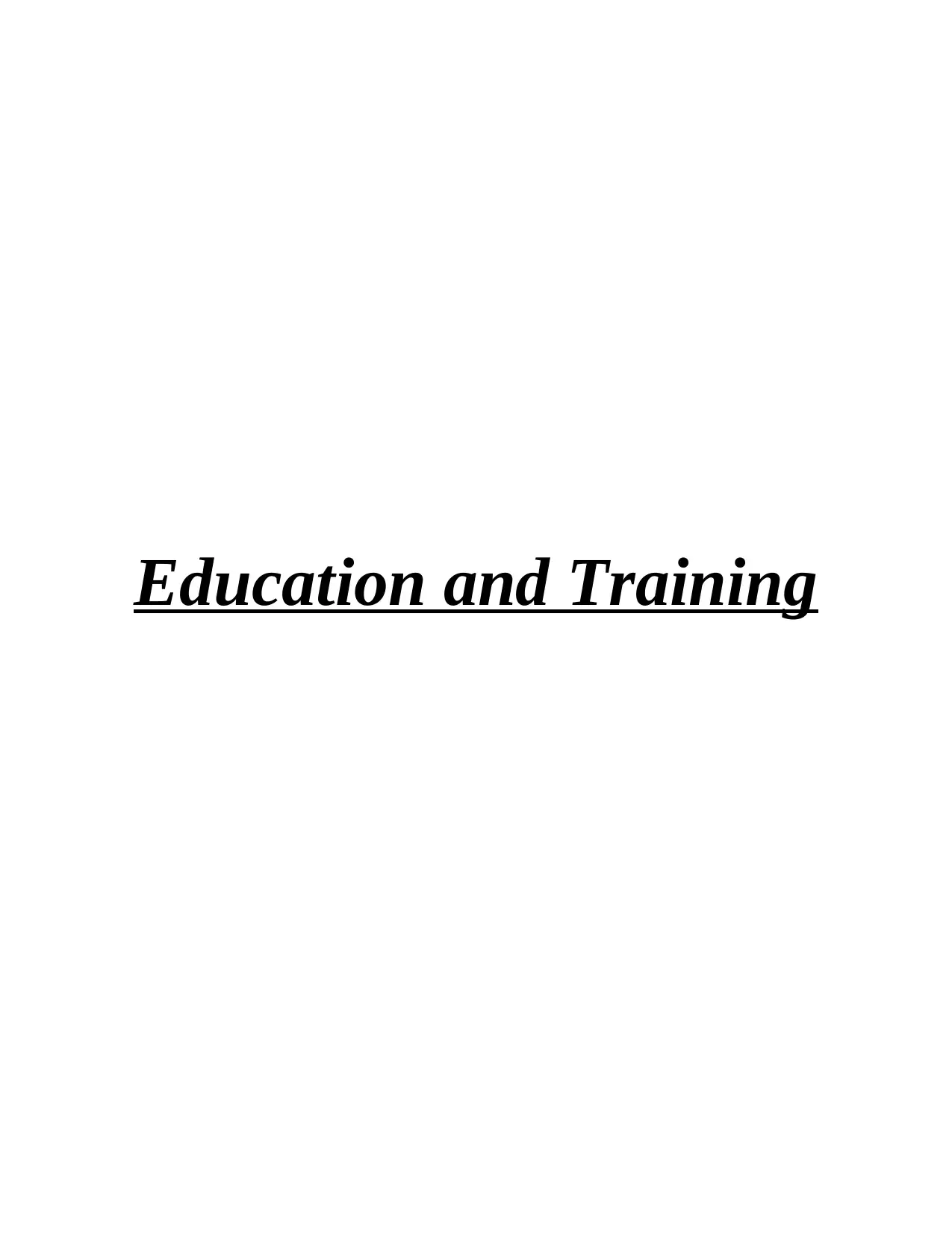
Education and Training
Paraphrase This Document
Need a fresh take? Get an instant paraphrase of this document with our AI Paraphraser
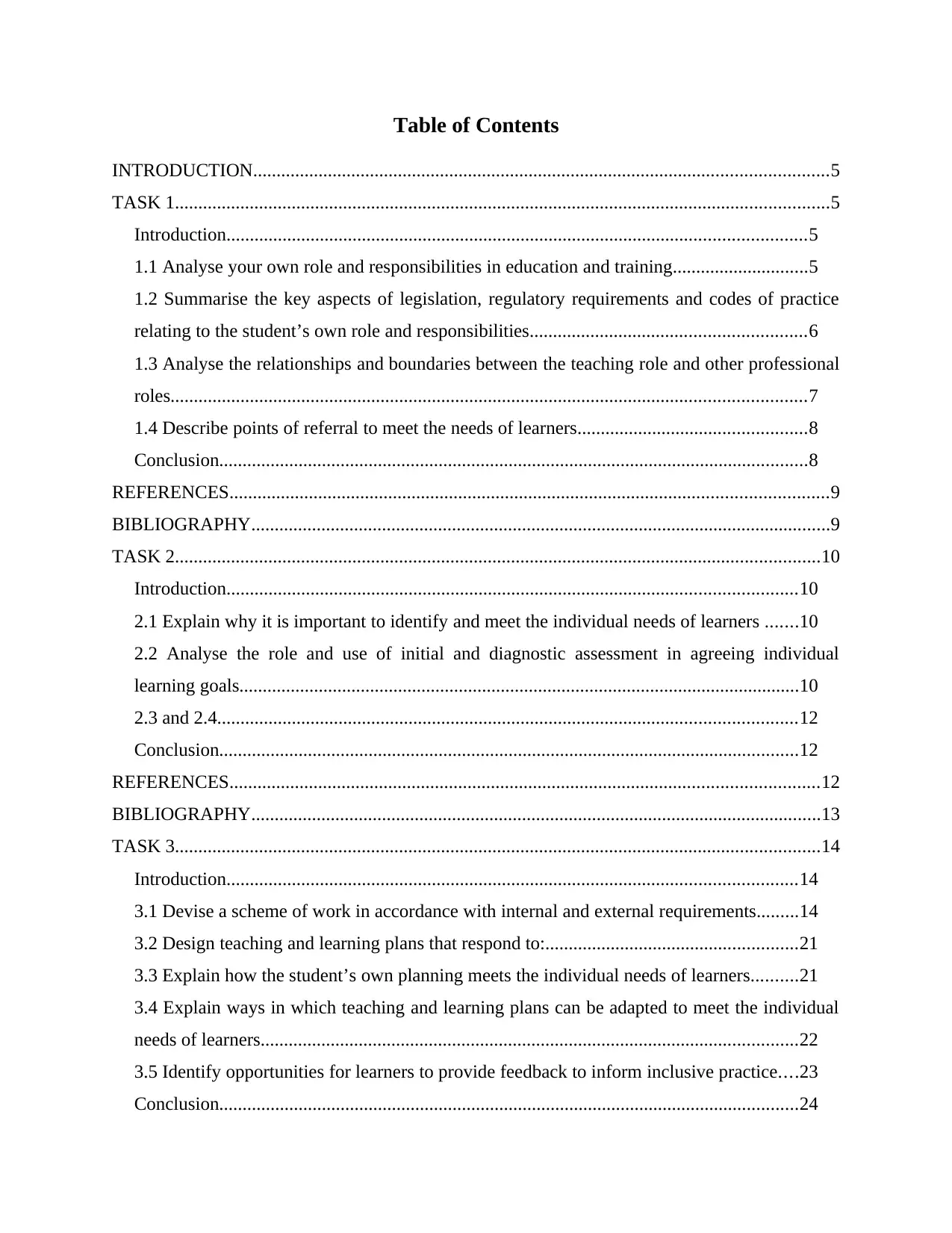
Table of Contents
INTRODUCTION...........................................................................................................................5
TASK 1............................................................................................................................................5
Introduction............................................................................................................................5
1.1 Analyse your own role and responsibilities in education and training.............................5
1.2 Summarise the key aspects of legislation, regulatory requirements and codes of practice
relating to the student’s own role and responsibilities...........................................................6
1.3 Analyse the relationships and boundaries between the teaching role and other professional
roles........................................................................................................................................7
1.4 Describe points of referral to meet the needs of learners.................................................8
Conclusion..............................................................................................................................8
REFERENCES................................................................................................................................9
BIBLIOGRAPHY............................................................................................................................9
TASK 2..........................................................................................................................................10
Introduction..........................................................................................................................10
2.1 Explain why it is important to identify and meet the individual needs of learners .......10
2.2 Analyse the role and use of initial and diagnostic assessment in agreeing individual
learning goals........................................................................................................................10
2.3 and 2.4............................................................................................................................12
Conclusion............................................................................................................................12
REFERENCES..............................................................................................................................12
BIBLIOGRAPHY..........................................................................................................................13
TASK 3..........................................................................................................................................14
Introduction..........................................................................................................................14
3.1 Devise a scheme of work in accordance with internal and external requirements.........14
3.2 Design teaching and learning plans that respond to:......................................................21
3.3 Explain how the student’s own planning meets the individual needs of learners..........21
3.4 Explain ways in which teaching and learning plans can be adapted to meet the individual
needs of learners...................................................................................................................22
3.5 Identify opportunities for learners to provide feedback to inform inclusive practice....23
Conclusion............................................................................................................................24
INTRODUCTION...........................................................................................................................5
TASK 1............................................................................................................................................5
Introduction............................................................................................................................5
1.1 Analyse your own role and responsibilities in education and training.............................5
1.2 Summarise the key aspects of legislation, regulatory requirements and codes of practice
relating to the student’s own role and responsibilities...........................................................6
1.3 Analyse the relationships and boundaries between the teaching role and other professional
roles........................................................................................................................................7
1.4 Describe points of referral to meet the needs of learners.................................................8
Conclusion..............................................................................................................................8
REFERENCES................................................................................................................................9
BIBLIOGRAPHY............................................................................................................................9
TASK 2..........................................................................................................................................10
Introduction..........................................................................................................................10
2.1 Explain why it is important to identify and meet the individual needs of learners .......10
2.2 Analyse the role and use of initial and diagnostic assessment in agreeing individual
learning goals........................................................................................................................10
2.3 and 2.4............................................................................................................................12
Conclusion............................................................................................................................12
REFERENCES..............................................................................................................................12
BIBLIOGRAPHY..........................................................................................................................13
TASK 3..........................................................................................................................................14
Introduction..........................................................................................................................14
3.1 Devise a scheme of work in accordance with internal and external requirements.........14
3.2 Design teaching and learning plans that respond to:......................................................21
3.3 Explain how the student’s own planning meets the individual needs of learners..........21
3.4 Explain ways in which teaching and learning plans can be adapted to meet the individual
needs of learners...................................................................................................................22
3.5 Identify opportunities for learners to provide feedback to inform inclusive practice....23
Conclusion............................................................................................................................24
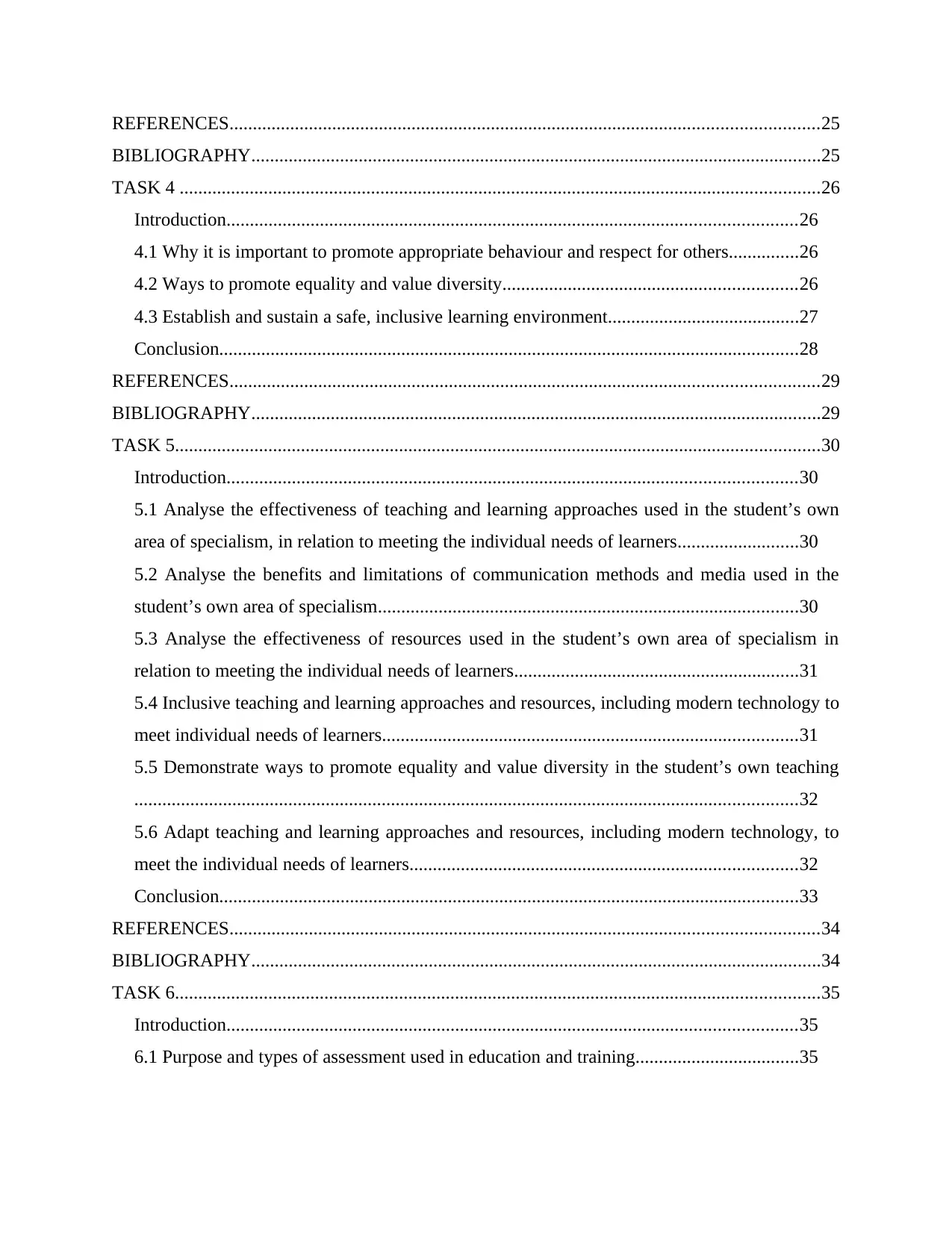
REFERENCES..............................................................................................................................25
BIBLIOGRAPHY..........................................................................................................................25
TASK 4 .........................................................................................................................................26
Introduction..........................................................................................................................26
4.1 Why it is important to promote appropriate behaviour and respect for others...............26
4.2 Ways to promote equality and value diversity...............................................................26
4.3 Establish and sustain a safe, inclusive learning environment.........................................27
Conclusion............................................................................................................................28
REFERENCES..............................................................................................................................29
BIBLIOGRAPHY..........................................................................................................................29
TASK 5..........................................................................................................................................30
Introduction..........................................................................................................................30
5.1 Analyse the effectiveness of teaching and learning approaches used in the student’s own
area of specialism, in relation to meeting the individual needs of learners..........................30
5.2 Analyse the benefits and limitations of communication methods and media used in the
student’s own area of specialism..........................................................................................30
5.3 Analyse the effectiveness of resources used in the student’s own area of specialism in
relation to meeting the individual needs of learners.............................................................31
5.4 Inclusive teaching and learning approaches and resources, including modern technology to
meet individual needs of learners.........................................................................................31
5.5 Demonstrate ways to promote equality and value diversity in the student’s own teaching
..............................................................................................................................................32
5.6 Adapt teaching and learning approaches and resources, including modern technology, to
meet the individual needs of learners...................................................................................32
Conclusion............................................................................................................................33
REFERENCES..............................................................................................................................34
BIBLIOGRAPHY..........................................................................................................................34
TASK 6..........................................................................................................................................35
Introduction..........................................................................................................................35
6.1 Purpose and types of assessment used in education and training...................................35
BIBLIOGRAPHY..........................................................................................................................25
TASK 4 .........................................................................................................................................26
Introduction..........................................................................................................................26
4.1 Why it is important to promote appropriate behaviour and respect for others...............26
4.2 Ways to promote equality and value diversity...............................................................26
4.3 Establish and sustain a safe, inclusive learning environment.........................................27
Conclusion............................................................................................................................28
REFERENCES..............................................................................................................................29
BIBLIOGRAPHY..........................................................................................................................29
TASK 5..........................................................................................................................................30
Introduction..........................................................................................................................30
5.1 Analyse the effectiveness of teaching and learning approaches used in the student’s own
area of specialism, in relation to meeting the individual needs of learners..........................30
5.2 Analyse the benefits and limitations of communication methods and media used in the
student’s own area of specialism..........................................................................................30
5.3 Analyse the effectiveness of resources used in the student’s own area of specialism in
relation to meeting the individual needs of learners.............................................................31
5.4 Inclusive teaching and learning approaches and resources, including modern technology to
meet individual needs of learners.........................................................................................31
5.5 Demonstrate ways to promote equality and value diversity in the student’s own teaching
..............................................................................................................................................32
5.6 Adapt teaching and learning approaches and resources, including modern technology, to
meet the individual needs of learners...................................................................................32
Conclusion............................................................................................................................33
REFERENCES..............................................................................................................................34
BIBLIOGRAPHY..........................................................................................................................34
TASK 6..........................................................................................................................................35
Introduction..........................................................................................................................35
6.1 Purpose and types of assessment used in education and training...................................35
⊘ This is a preview!⊘
Do you want full access?
Subscribe today to unlock all pages.

Trusted by 1+ million students worldwide
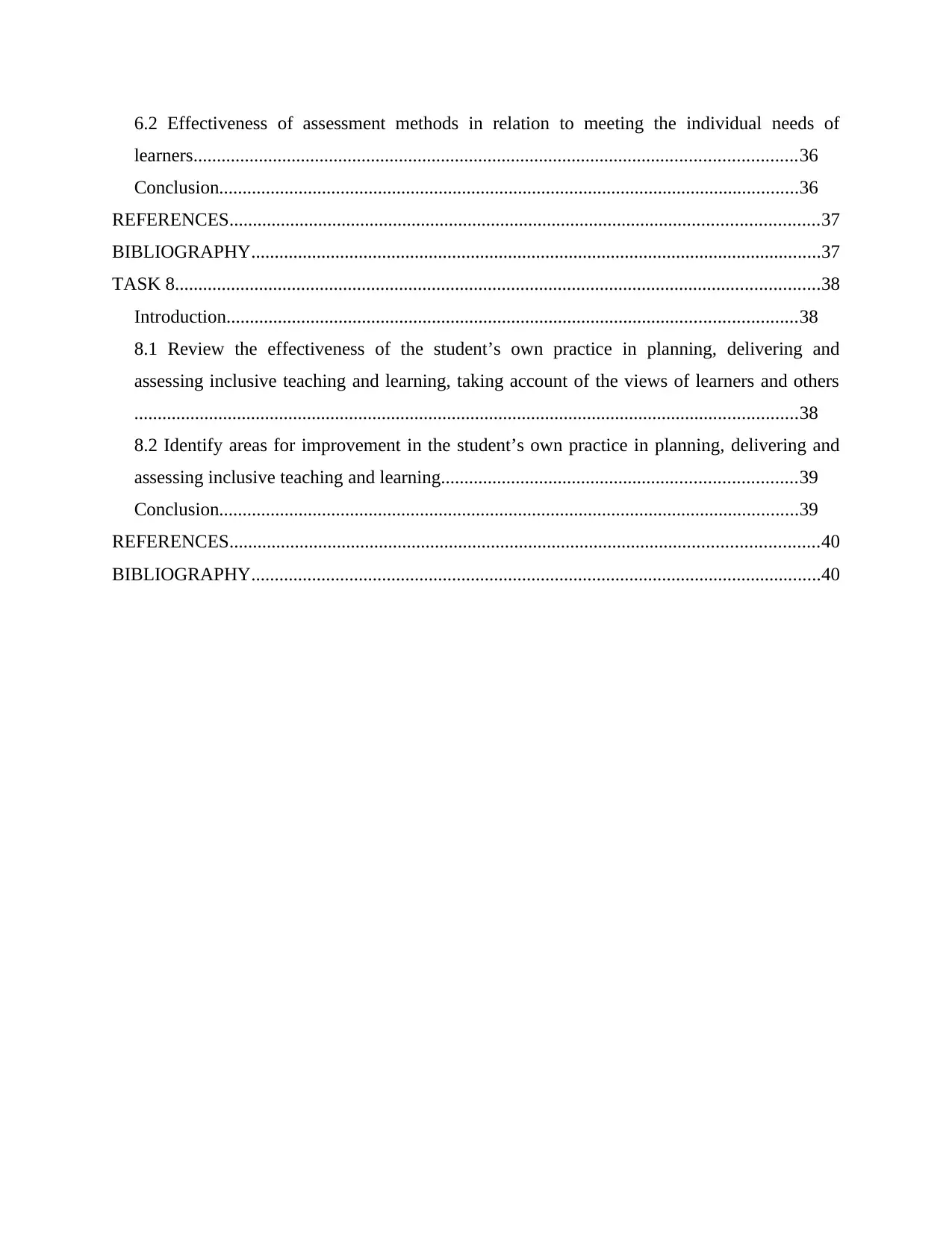
6.2 Effectiveness of assessment methods in relation to meeting the individual needs of
learners.................................................................................................................................36
Conclusion............................................................................................................................36
REFERENCES..............................................................................................................................37
BIBLIOGRAPHY..........................................................................................................................37
TASK 8..........................................................................................................................................38
Introduction..........................................................................................................................38
8.1 Review the effectiveness of the student’s own practice in planning, delivering and
assessing inclusive teaching and learning, taking account of the views of learners and others
..............................................................................................................................................38
8.2 Identify areas for improvement in the student’s own practice in planning, delivering and
assessing inclusive teaching and learning............................................................................39
Conclusion............................................................................................................................39
REFERENCES..............................................................................................................................40
BIBLIOGRAPHY..........................................................................................................................40
learners.................................................................................................................................36
Conclusion............................................................................................................................36
REFERENCES..............................................................................................................................37
BIBLIOGRAPHY..........................................................................................................................37
TASK 8..........................................................................................................................................38
Introduction..........................................................................................................................38
8.1 Review the effectiveness of the student’s own practice in planning, delivering and
assessing inclusive teaching and learning, taking account of the views of learners and others
..............................................................................................................................................38
8.2 Identify areas for improvement in the student’s own practice in planning, delivering and
assessing inclusive teaching and learning............................................................................39
Conclusion............................................................................................................................39
REFERENCES..............................................................................................................................40
BIBLIOGRAPHY..........................................................................................................................40
Paraphrase This Document
Need a fresh take? Get an instant paraphrase of this document with our AI Paraphraser
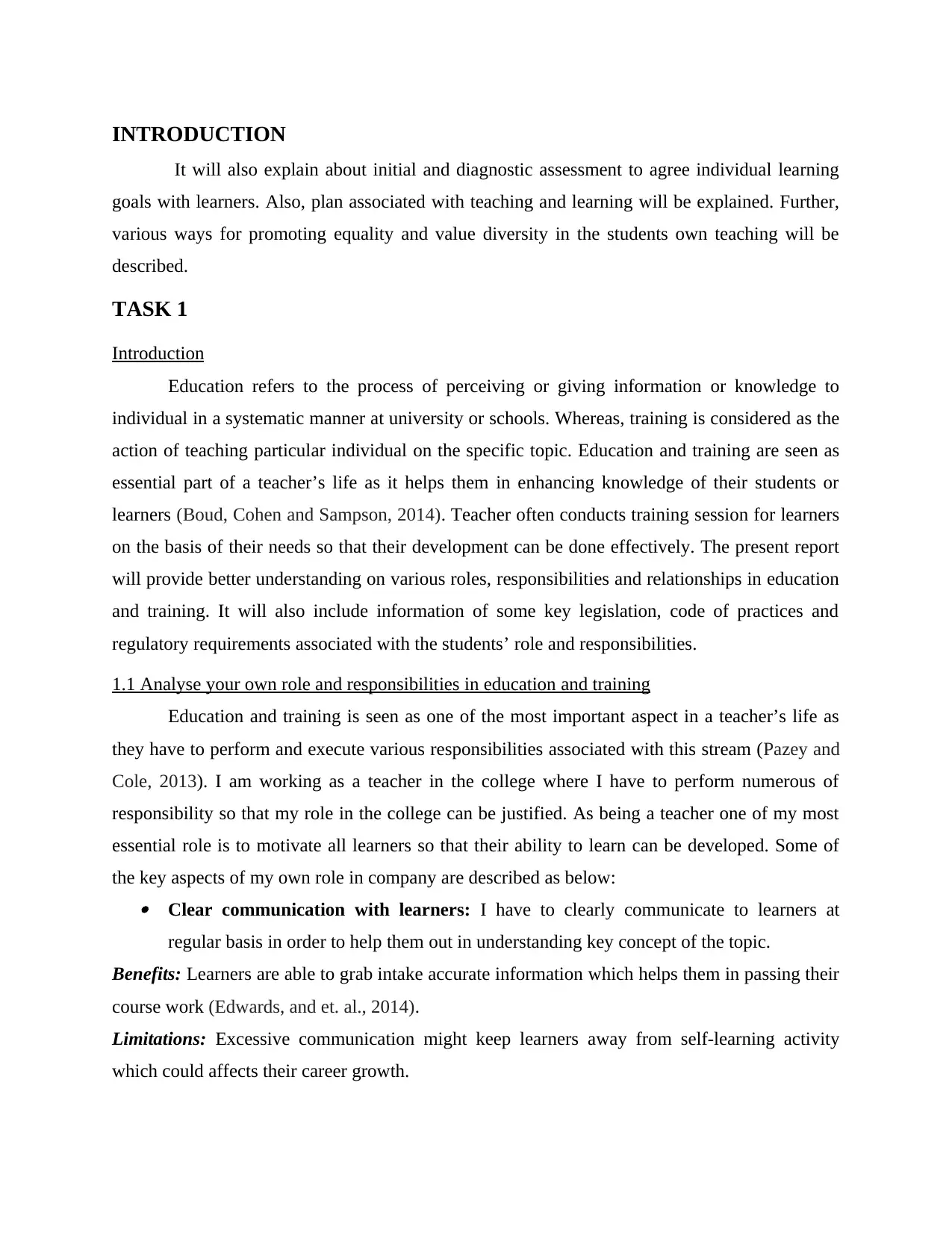
INTRODUCTION
It will also explain about initial and diagnostic assessment to agree individual learning
goals with learners. Also, plan associated with teaching and learning will be explained. Further,
various ways for promoting equality and value diversity in the students own teaching will be
described.
TASK 1
Introduction
Education refers to the process of perceiving or giving information or knowledge to
individual in a systematic manner at university or schools. Whereas, training is considered as the
action of teaching particular individual on the specific topic. Education and training are seen as
essential part of a teacher’s life as it helps them in enhancing knowledge of their students or
learners (Boud, Cohen and Sampson, 2014). Teacher often conducts training session for learners
on the basis of their needs so that their development can be done effectively. The present report
will provide better understanding on various roles, responsibilities and relationships in education
and training. It will also include information of some key legislation, code of practices and
regulatory requirements associated with the students’ role and responsibilities.
1.1 Analyse your own role and responsibilities in education and training
Education and training is seen as one of the most important aspect in a teacher’s life as
they have to perform and execute various responsibilities associated with this stream (Pazey and
Cole, 2013). I am working as a teacher in the college where I have to perform numerous of
responsibility so that my role in the college can be justified. As being a teacher one of my most
essential role is to motivate all learners so that their ability to learn can be developed. Some of
the key aspects of my own role in company are described as below: Clear communication with learners: I have to clearly communicate to learners at
regular basis in order to help them out in understanding key concept of the topic.
Benefits: Learners are able to grab intake accurate information which helps them in passing their
course work (Edwards, and et. al., 2014).
Limitations: Excessive communication might keep learners away from self-learning activity
which could affects their career growth.
It will also explain about initial and diagnostic assessment to agree individual learning
goals with learners. Also, plan associated with teaching and learning will be explained. Further,
various ways for promoting equality and value diversity in the students own teaching will be
described.
TASK 1
Introduction
Education refers to the process of perceiving or giving information or knowledge to
individual in a systematic manner at university or schools. Whereas, training is considered as the
action of teaching particular individual on the specific topic. Education and training are seen as
essential part of a teacher’s life as it helps them in enhancing knowledge of their students or
learners (Boud, Cohen and Sampson, 2014). Teacher often conducts training session for learners
on the basis of their needs so that their development can be done effectively. The present report
will provide better understanding on various roles, responsibilities and relationships in education
and training. It will also include information of some key legislation, code of practices and
regulatory requirements associated with the students’ role and responsibilities.
1.1 Analyse your own role and responsibilities in education and training
Education and training is seen as one of the most important aspect in a teacher’s life as
they have to perform and execute various responsibilities associated with this stream (Pazey and
Cole, 2013). I am working as a teacher in the college where I have to perform numerous of
responsibility so that my role in the college can be justified. As being a teacher one of my most
essential role is to motivate all learners so that their ability to learn can be developed. Some of
the key aspects of my own role in company are described as below: Clear communication with learners: I have to clearly communicate to learners at
regular basis in order to help them out in understanding key concept of the topic.
Benefits: Learners are able to grab intake accurate information which helps them in passing their
course work (Edwards, and et. al., 2014).
Limitations: Excessive communication might keep learners away from self-learning activity
which could affects their career growth.
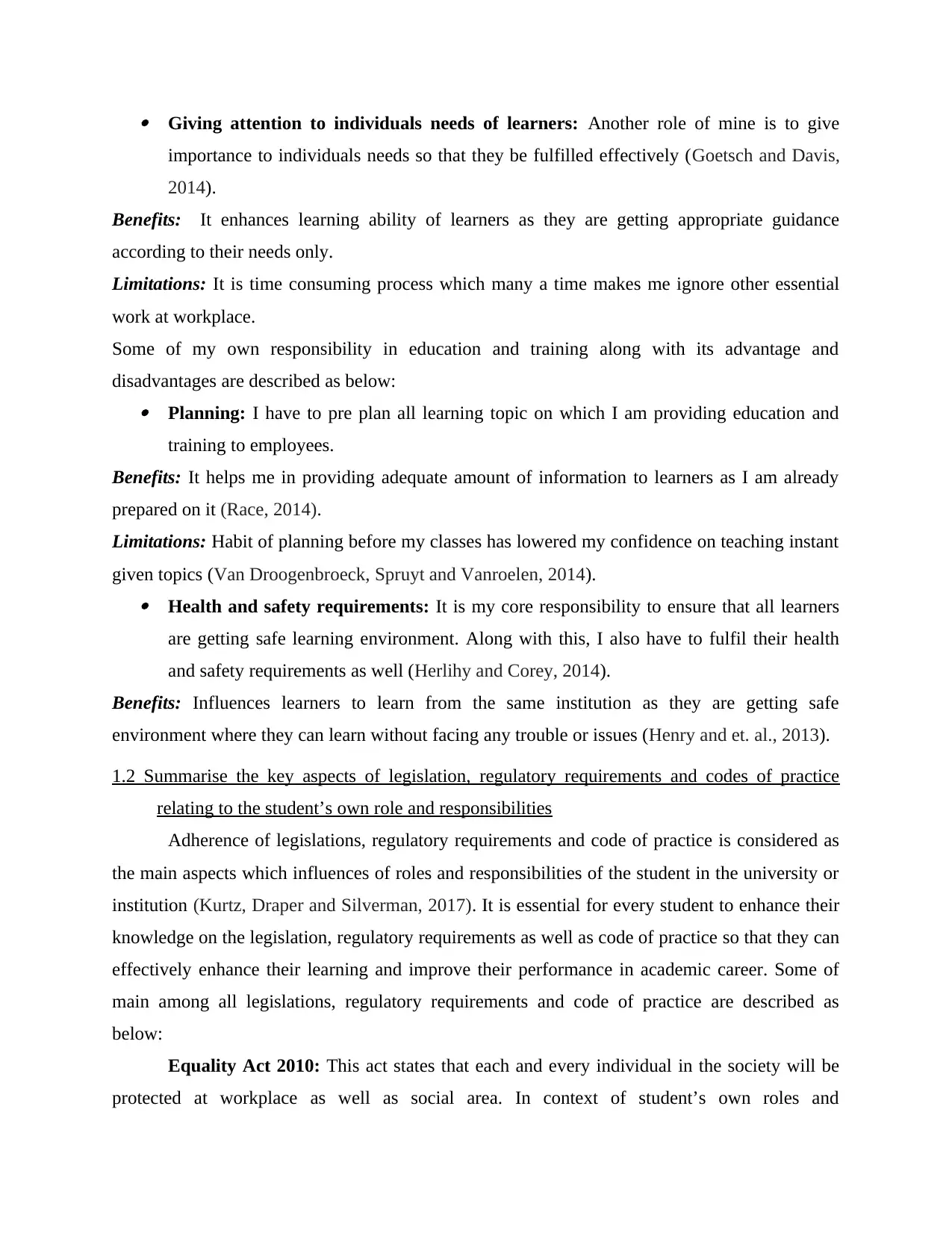
Giving attention to individuals needs of learners: Another role of mine is to give
importance to individuals needs so that they be fulfilled effectively (Goetsch and Davis,
2014).
Benefits: It enhances learning ability of learners as they are getting appropriate guidance
according to their needs only.
Limitations: It is time consuming process which many a time makes me ignore other essential
work at workplace.
Some of my own responsibility in education and training along with its advantage and
disadvantages are described as below: Planning: I have to pre plan all learning topic on which I am providing education and
training to employees.
Benefits: It helps me in providing adequate amount of information to learners as I am already
prepared on it (Race, 2014).
Limitations: Habit of planning before my classes has lowered my confidence on teaching instant
given topics (Van Droogenbroeck, Spruyt and Vanroelen, 2014). Health and safety requirements: It is my core responsibility to ensure that all learners
are getting safe learning environment. Along with this, I also have to fulfil their health
and safety requirements as well (Herlihy and Corey, 2014).
Benefits: Influences learners to learn from the same institution as they are getting safe
environment where they can learn without facing any trouble or issues (Henry and et. al., 2013).
1.2 Summarise the key aspects of legislation, regulatory requirements and codes of practice
relating to the student’s own role and responsibilities
Adherence of legislations, regulatory requirements and code of practice is considered as
the main aspects which influences of roles and responsibilities of the student in the university or
institution (Kurtz, Draper and Silverman, 2017). It is essential for every student to enhance their
knowledge on the legislation, regulatory requirements as well as code of practice so that they can
effectively enhance their learning and improve their performance in academic career. Some of
main among all legislations, regulatory requirements and code of practice are described as
below:
Equality Act 2010: This act states that each and every individual in the society will be
protected at workplace as well as social area. In context of student’s own roles and
importance to individuals needs so that they be fulfilled effectively (Goetsch and Davis,
2014).
Benefits: It enhances learning ability of learners as they are getting appropriate guidance
according to their needs only.
Limitations: It is time consuming process which many a time makes me ignore other essential
work at workplace.
Some of my own responsibility in education and training along with its advantage and
disadvantages are described as below: Planning: I have to pre plan all learning topic on which I am providing education and
training to employees.
Benefits: It helps me in providing adequate amount of information to learners as I am already
prepared on it (Race, 2014).
Limitations: Habit of planning before my classes has lowered my confidence on teaching instant
given topics (Van Droogenbroeck, Spruyt and Vanroelen, 2014). Health and safety requirements: It is my core responsibility to ensure that all learners
are getting safe learning environment. Along with this, I also have to fulfil their health
and safety requirements as well (Herlihy and Corey, 2014).
Benefits: Influences learners to learn from the same institution as they are getting safe
environment where they can learn without facing any trouble or issues (Henry and et. al., 2013).
1.2 Summarise the key aspects of legislation, regulatory requirements and codes of practice
relating to the student’s own role and responsibilities
Adherence of legislations, regulatory requirements and code of practice is considered as
the main aspects which influences of roles and responsibilities of the student in the university or
institution (Kurtz, Draper and Silverman, 2017). It is essential for every student to enhance their
knowledge on the legislation, regulatory requirements as well as code of practice so that they can
effectively enhance their learning and improve their performance in academic career. Some of
main among all legislations, regulatory requirements and code of practice are described as
below:
Equality Act 2010: This act states that each and every individual in the society will be
protected at workplace as well as social area. In context of student’s own roles and
⊘ This is a preview!⊘
Do you want full access?
Subscribe today to unlock all pages.

Trusted by 1+ million students worldwide
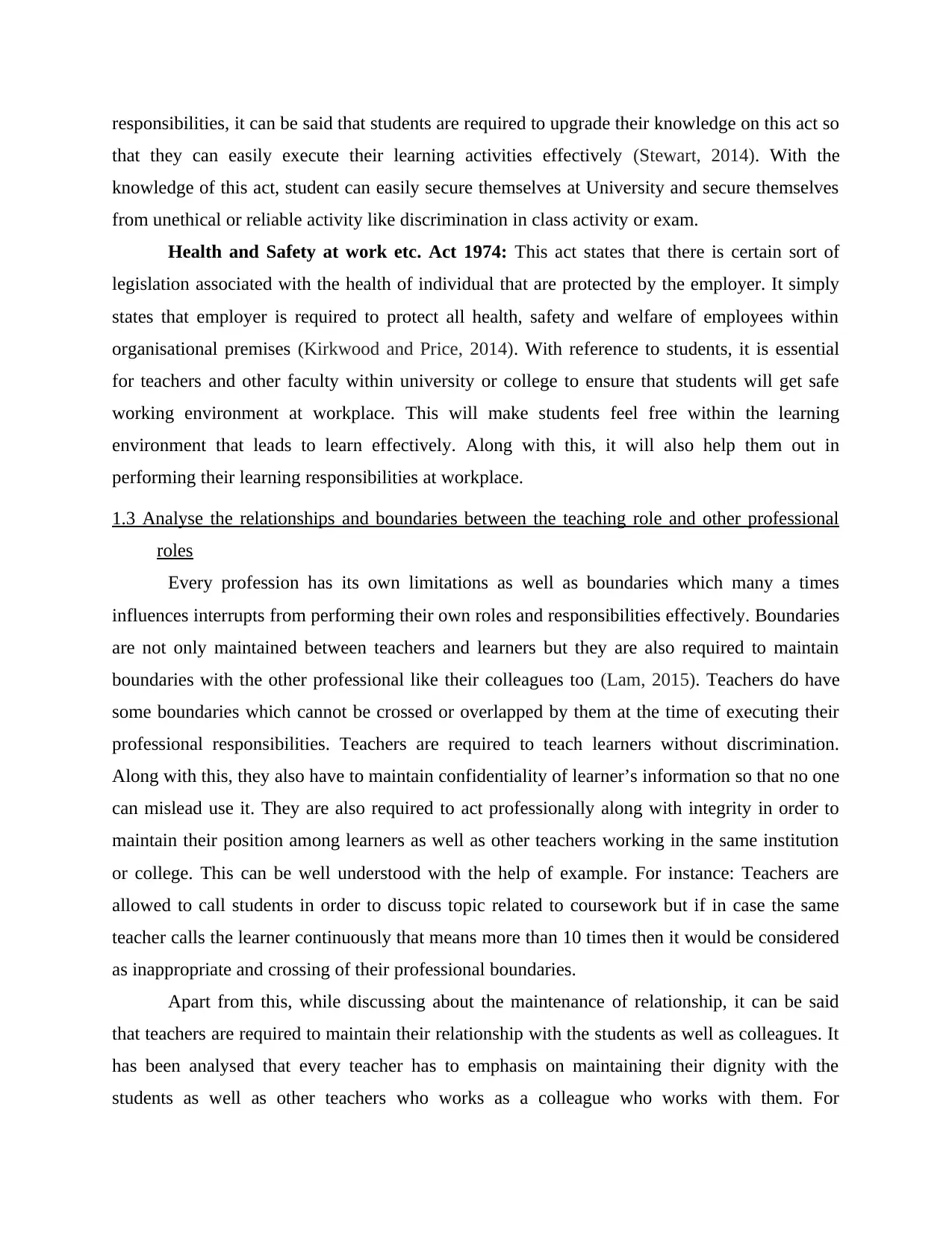
responsibilities, it can be said that students are required to upgrade their knowledge on this act so
that they can easily execute their learning activities effectively (Stewart, 2014). With the
knowledge of this act, student can easily secure themselves at University and secure themselves
from unethical or reliable activity like discrimination in class activity or exam.
Health and Safety at work etc. Act 1974: This act states that there is certain sort of
legislation associated with the health of individual that are protected by the employer. It simply
states that employer is required to protect all health, safety and welfare of employees within
organisational premises (Kirkwood and Price, 2014). With reference to students, it is essential
for teachers and other faculty within university or college to ensure that students will get safe
working environment at workplace. This will make students feel free within the learning
environment that leads to learn effectively. Along with this, it will also help them out in
performing their learning responsibilities at workplace.
1.3 Analyse the relationships and boundaries between the teaching role and other professional
roles
Every profession has its own limitations as well as boundaries which many a times
influences interrupts from performing their own roles and responsibilities effectively. Boundaries
are not only maintained between teachers and learners but they are also required to maintain
boundaries with the other professional like their colleagues too (Lam, 2015). Teachers do have
some boundaries which cannot be crossed or overlapped by them at the time of executing their
professional responsibilities. Teachers are required to teach learners without discrimination.
Along with this, they also have to maintain confidentiality of learner’s information so that no one
can mislead use it. They are also required to act professionally along with integrity in order to
maintain their position among learners as well as other teachers working in the same institution
or college. This can be well understood with the help of example. For instance: Teachers are
allowed to call students in order to discuss topic related to coursework but if in case the same
teacher calls the learner continuously that means more than 10 times then it would be considered
as inappropriate and crossing of their professional boundaries.
Apart from this, while discussing about the maintenance of relationship, it can be said
that teachers are required to maintain their relationship with the students as well as colleagues. It
has been analysed that every teacher has to emphasis on maintaining their dignity with the
students as well as other teachers who works as a colleague who works with them. For
that they can easily execute their learning activities effectively (Stewart, 2014). With the
knowledge of this act, student can easily secure themselves at University and secure themselves
from unethical or reliable activity like discrimination in class activity or exam.
Health and Safety at work etc. Act 1974: This act states that there is certain sort of
legislation associated with the health of individual that are protected by the employer. It simply
states that employer is required to protect all health, safety and welfare of employees within
organisational premises (Kirkwood and Price, 2014). With reference to students, it is essential
for teachers and other faculty within university or college to ensure that students will get safe
working environment at workplace. This will make students feel free within the learning
environment that leads to learn effectively. Along with this, it will also help them out in
performing their learning responsibilities at workplace.
1.3 Analyse the relationships and boundaries between the teaching role and other professional
roles
Every profession has its own limitations as well as boundaries which many a times
influences interrupts from performing their own roles and responsibilities effectively. Boundaries
are not only maintained between teachers and learners but they are also required to maintain
boundaries with the other professional like their colleagues too (Lam, 2015). Teachers do have
some boundaries which cannot be crossed or overlapped by them at the time of executing their
professional responsibilities. Teachers are required to teach learners without discrimination.
Along with this, they also have to maintain confidentiality of learner’s information so that no one
can mislead use it. They are also required to act professionally along with integrity in order to
maintain their position among learners as well as other teachers working in the same institution
or college. This can be well understood with the help of example. For instance: Teachers are
allowed to call students in order to discuss topic related to coursework but if in case the same
teacher calls the learner continuously that means more than 10 times then it would be considered
as inappropriate and crossing of their professional boundaries.
Apart from this, while discussing about the maintenance of relationship, it can be said
that teachers are required to maintain their relationship with the students as well as colleagues. It
has been analysed that every teacher has to emphasis on maintaining their dignity with the
students as well as other teachers who works as a colleague who works with them. For
Paraphrase This Document
Need a fresh take? Get an instant paraphrase of this document with our AI Paraphraser
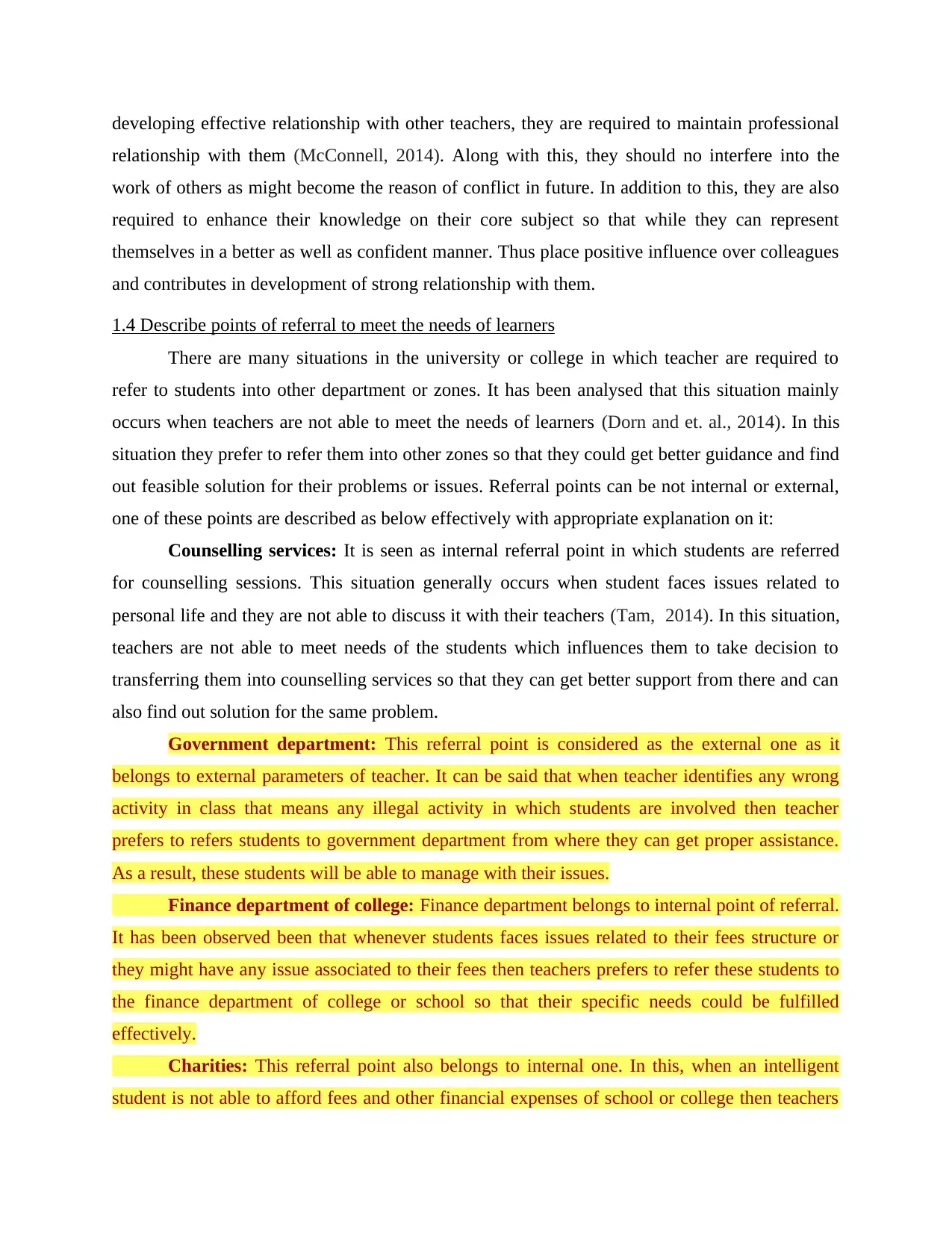
developing effective relationship with other teachers, they are required to maintain professional
relationship with them (McConnell, 2014). Along with this, they should no interfere into the
work of others as might become the reason of conflict in future. In addition to this, they are also
required to enhance their knowledge on their core subject so that while they can represent
themselves in a better as well as confident manner. Thus place positive influence over colleagues
and contributes in development of strong relationship with them.
1.4 Describe points of referral to meet the needs of learners
There are many situations in the university or college in which teacher are required to
refer to students into other department or zones. It has been analysed that this situation mainly
occurs when teachers are not able to meet the needs of learners (Dorn and et. al., 2014). In this
situation they prefer to refer them into other zones so that they could get better guidance and find
out feasible solution for their problems or issues. Referral points can be not internal or external,
one of these points are described as below effectively with appropriate explanation on it:
Counselling services: It is seen as internal referral point in which students are referred
for counselling sessions. This situation generally occurs when student faces issues related to
personal life and they are not able to discuss it with their teachers (Tam, 2014). In this situation,
teachers are not able to meet needs of the students which influences them to take decision to
transferring them into counselling services so that they can get better support from there and can
also find out solution for the same problem.
Government department: This referral point is considered as the external one as it
belongs to external parameters of teacher. It can be said that when teacher identifies any wrong
activity in class that means any illegal activity in which students are involved then teacher
prefers to refers students to government department from where they can get proper assistance.
As a result, these students will be able to manage with their issues.
Finance department of college: Finance department belongs to internal point of referral.
It has been observed been that whenever students faces issues related to their fees structure or
they might have any issue associated to their fees then teachers prefers to refer these students to
the finance department of college or school so that their specific needs could be fulfilled
effectively.
Charities: This referral point also belongs to internal one. In this, when an intelligent
student is not able to afford fees and other financial expenses of school or college then teachers
relationship with them (McConnell, 2014). Along with this, they should no interfere into the
work of others as might become the reason of conflict in future. In addition to this, they are also
required to enhance their knowledge on their core subject so that while they can represent
themselves in a better as well as confident manner. Thus place positive influence over colleagues
and contributes in development of strong relationship with them.
1.4 Describe points of referral to meet the needs of learners
There are many situations in the university or college in which teacher are required to
refer to students into other department or zones. It has been analysed that this situation mainly
occurs when teachers are not able to meet the needs of learners (Dorn and et. al., 2014). In this
situation they prefer to refer them into other zones so that they could get better guidance and find
out feasible solution for their problems or issues. Referral points can be not internal or external,
one of these points are described as below effectively with appropriate explanation on it:
Counselling services: It is seen as internal referral point in which students are referred
for counselling sessions. This situation generally occurs when student faces issues related to
personal life and they are not able to discuss it with their teachers (Tam, 2014). In this situation,
teachers are not able to meet needs of the students which influences them to take decision to
transferring them into counselling services so that they can get better support from there and can
also find out solution for the same problem.
Government department: This referral point is considered as the external one as it
belongs to external parameters of teacher. It can be said that when teacher identifies any wrong
activity in class that means any illegal activity in which students are involved then teacher
prefers to refers students to government department from where they can get proper assistance.
As a result, these students will be able to manage with their issues.
Finance department of college: Finance department belongs to internal point of referral.
It has been observed been that whenever students faces issues related to their fees structure or
they might have any issue associated to their fees then teachers prefers to refer these students to
the finance department of college or school so that their specific needs could be fulfilled
effectively.
Charities: This referral point also belongs to internal one. In this, when an intelligent
student is not able to afford fees and other financial expenses of school or college then teachers
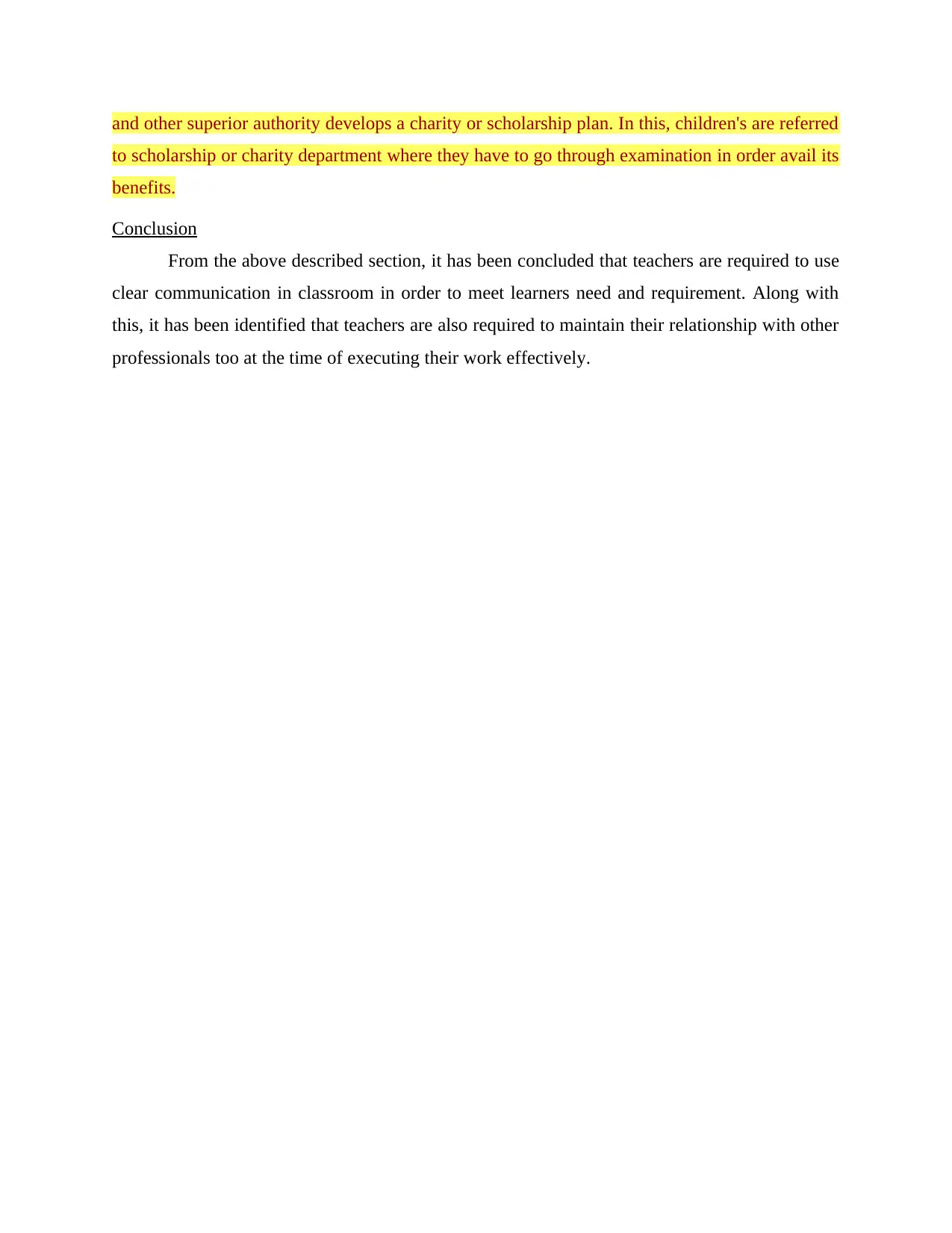
and other superior authority develops a charity or scholarship plan. In this, children's are referred
to scholarship or charity department where they have to go through examination in order avail its
benefits.
Conclusion
From the above described section, it has been concluded that teachers are required to use
clear communication in classroom in order to meet learners need and requirement. Along with
this, it has been identified that teachers are also required to maintain their relationship with other
professionals too at the time of executing their work effectively.
to scholarship or charity department where they have to go through examination in order avail its
benefits.
Conclusion
From the above described section, it has been concluded that teachers are required to use
clear communication in classroom in order to meet learners need and requirement. Along with
this, it has been identified that teachers are also required to maintain their relationship with other
professionals too at the time of executing their work effectively.
⊘ This is a preview!⊘
Do you want full access?
Subscribe today to unlock all pages.

Trusted by 1+ million students worldwide
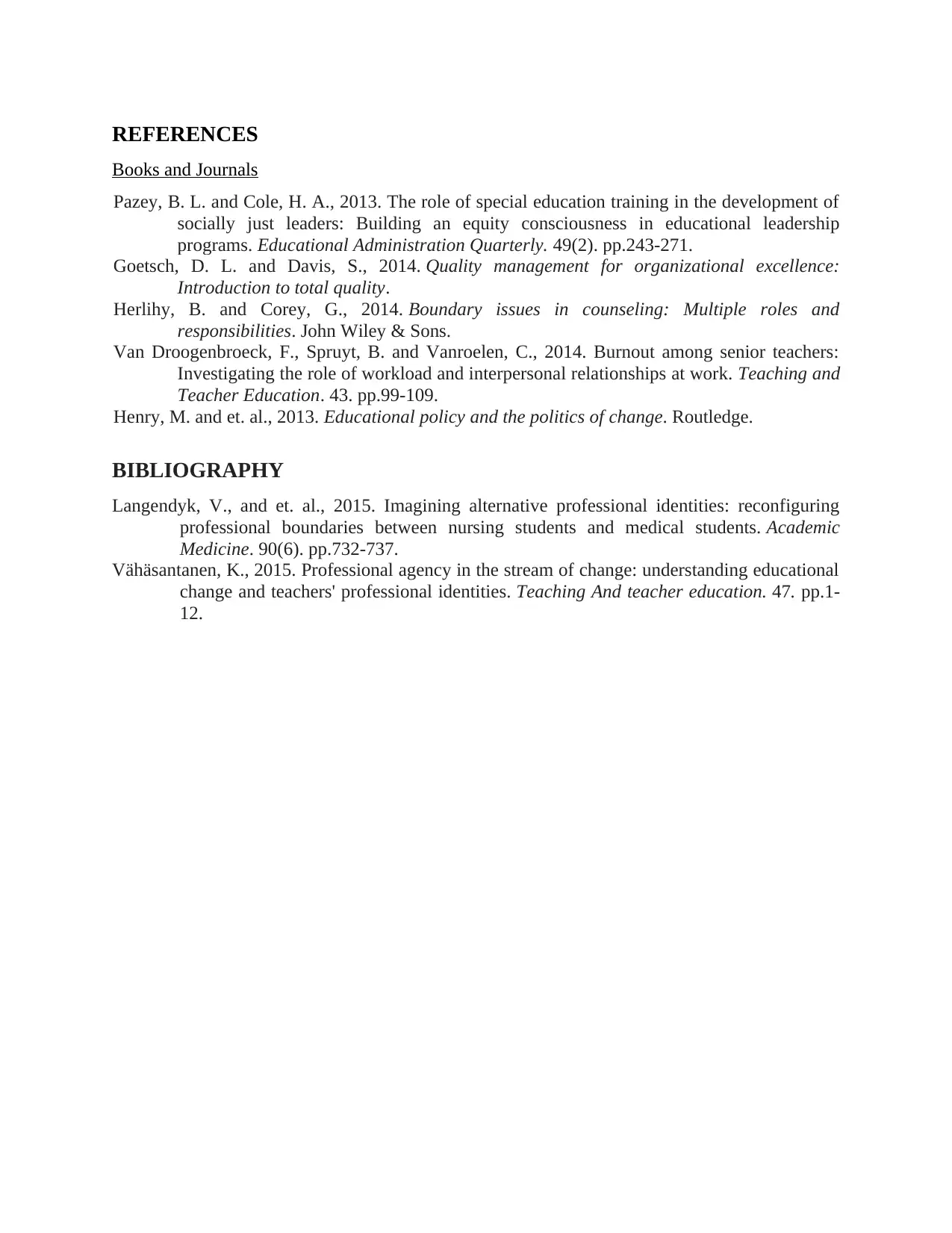
REFERENCES
Books and Journals
Pazey, B. L. and Cole, H. A., 2013. The role of special education training in the development of
socially just leaders: Building an equity consciousness in educational leadership
programs. Educational Administration Quarterly. 49(2). pp.243-271.
Goetsch, D. L. and Davis, S., 2014. Quality management for organizational excellence:
Introduction to total quality.
Herlihy, B. and Corey, G., 2014. Boundary issues in counseling: Multiple roles and
responsibilities. John Wiley & Sons.
Van Droogenbroeck, F., Spruyt, B. and Vanroelen, C., 2014. Burnout among senior teachers:
Investigating the role of workload and interpersonal relationships at work. Teaching and
Teacher Education. 43. pp.99-109.
Henry, M. and et. al., 2013. Educational policy and the politics of change. Routledge.
BIBLIOGRAPHY
Langendyk, V., and et. al., 2015. Imagining alternative professional identities: reconfiguring
professional boundaries between nursing students and medical students. Academic
Medicine. 90(6). pp.732-737.
Vähäsantanen, K., 2015. Professional agency in the stream of change: understanding educational
change and teachers' professional identities. Teaching And teacher education. 47. pp.1-
12.
Books and Journals
Pazey, B. L. and Cole, H. A., 2013. The role of special education training in the development of
socially just leaders: Building an equity consciousness in educational leadership
programs. Educational Administration Quarterly. 49(2). pp.243-271.
Goetsch, D. L. and Davis, S., 2014. Quality management for organizational excellence:
Introduction to total quality.
Herlihy, B. and Corey, G., 2014. Boundary issues in counseling: Multiple roles and
responsibilities. John Wiley & Sons.
Van Droogenbroeck, F., Spruyt, B. and Vanroelen, C., 2014. Burnout among senior teachers:
Investigating the role of workload and interpersonal relationships at work. Teaching and
Teacher Education. 43. pp.99-109.
Henry, M. and et. al., 2013. Educational policy and the politics of change. Routledge.
BIBLIOGRAPHY
Langendyk, V., and et. al., 2015. Imagining alternative professional identities: reconfiguring
professional boundaries between nursing students and medical students. Academic
Medicine. 90(6). pp.732-737.
Vähäsantanen, K., 2015. Professional agency in the stream of change: understanding educational
change and teachers' professional identities. Teaching And teacher education. 47. pp.1-
12.
Paraphrase This Document
Need a fresh take? Get an instant paraphrase of this document with our AI Paraphraser
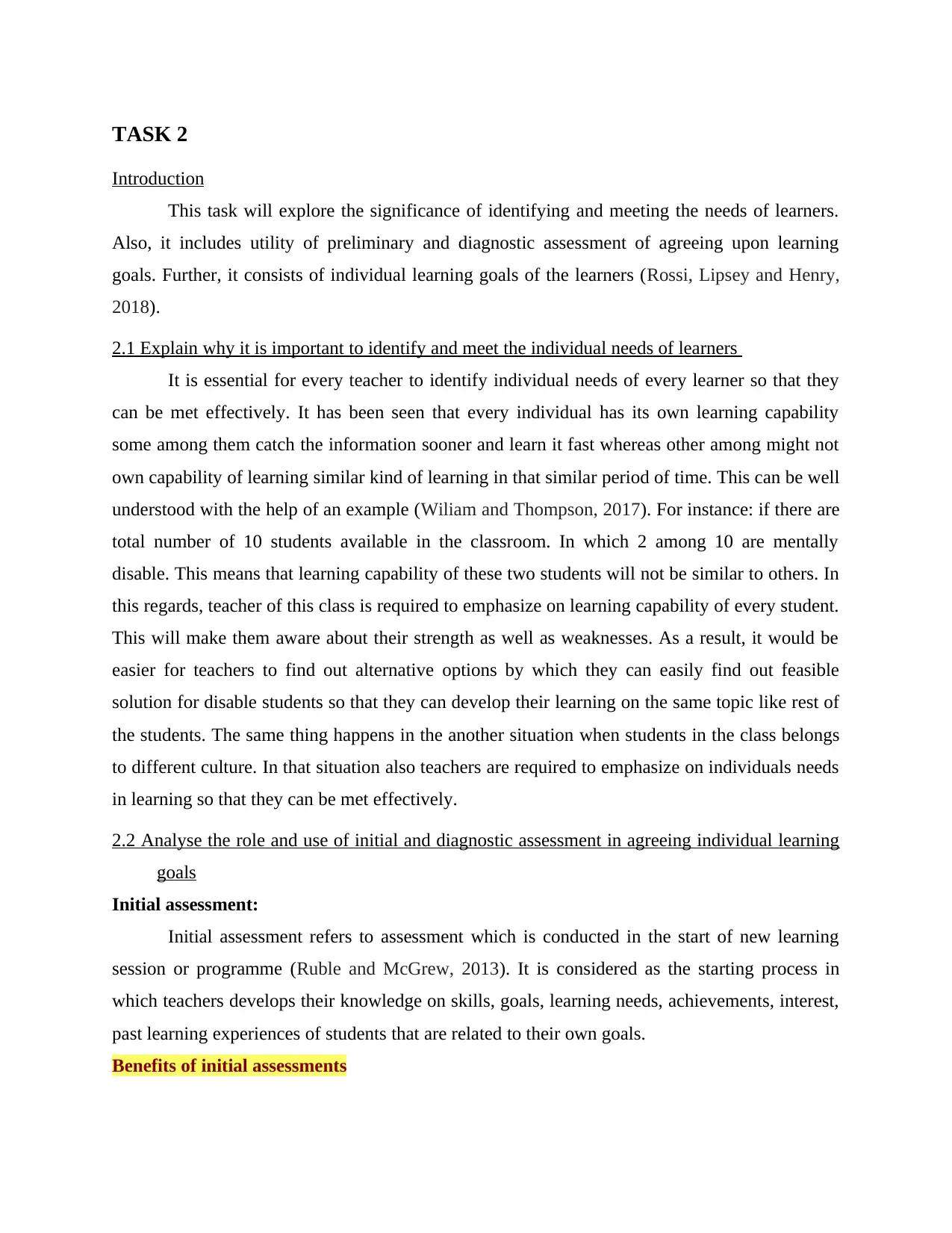
TASK 2
Introduction
This task will explore the significance of identifying and meeting the needs of learners.
Also, it includes utility of preliminary and diagnostic assessment of agreeing upon learning
goals. Further, it consists of individual learning goals of the learners (Rossi, Lipsey and Henry,
2018).
2.1 Explain why it is important to identify and meet the individual needs of learners
It is essential for every teacher to identify individual needs of every learner so that they
can be met effectively. It has been seen that every individual has its own learning capability
some among them catch the information sooner and learn it fast whereas other among might not
own capability of learning similar kind of learning in that similar period of time. This can be well
understood with the help of an example (Wiliam and Thompson, 2017). For instance: if there are
total number of 10 students available in the classroom. In which 2 among 10 are mentally
disable. This means that learning capability of these two students will not be similar to others. In
this regards, teacher of this class is required to emphasize on learning capability of every student.
This will make them aware about their strength as well as weaknesses. As a result, it would be
easier for teachers to find out alternative options by which they can easily find out feasible
solution for disable students so that they can develop their learning on the same topic like rest of
the students. The same thing happens in the another situation when students in the class belongs
to different culture. In that situation also teachers are required to emphasize on individuals needs
in learning so that they can be met effectively.
2.2 Analyse the role and use of initial and diagnostic assessment in agreeing individual learning
goals
Initial assessment:
Initial assessment refers to assessment which is conducted in the start of new learning
session or programme (Ruble and McGrew, 2013). It is considered as the starting process in
which teachers develops their knowledge on skills, goals, learning needs, achievements, interest,
past learning experiences of students that are related to their own goals.
Benefits of initial assessments
Introduction
This task will explore the significance of identifying and meeting the needs of learners.
Also, it includes utility of preliminary and diagnostic assessment of agreeing upon learning
goals. Further, it consists of individual learning goals of the learners (Rossi, Lipsey and Henry,
2018).
2.1 Explain why it is important to identify and meet the individual needs of learners
It is essential for every teacher to identify individual needs of every learner so that they
can be met effectively. It has been seen that every individual has its own learning capability
some among them catch the information sooner and learn it fast whereas other among might not
own capability of learning similar kind of learning in that similar period of time. This can be well
understood with the help of an example (Wiliam and Thompson, 2017). For instance: if there are
total number of 10 students available in the classroom. In which 2 among 10 are mentally
disable. This means that learning capability of these two students will not be similar to others. In
this regards, teacher of this class is required to emphasize on learning capability of every student.
This will make them aware about their strength as well as weaknesses. As a result, it would be
easier for teachers to find out alternative options by which they can easily find out feasible
solution for disable students so that they can develop their learning on the same topic like rest of
the students. The same thing happens in the another situation when students in the class belongs
to different culture. In that situation also teachers are required to emphasize on individuals needs
in learning so that they can be met effectively.
2.2 Analyse the role and use of initial and diagnostic assessment in agreeing individual learning
goals
Initial assessment:
Initial assessment refers to assessment which is conducted in the start of new learning
session or programme (Ruble and McGrew, 2013). It is considered as the starting process in
which teachers develops their knowledge on skills, goals, learning needs, achievements, interest,
past learning experiences of students that are related to their own goals.
Benefits of initial assessments
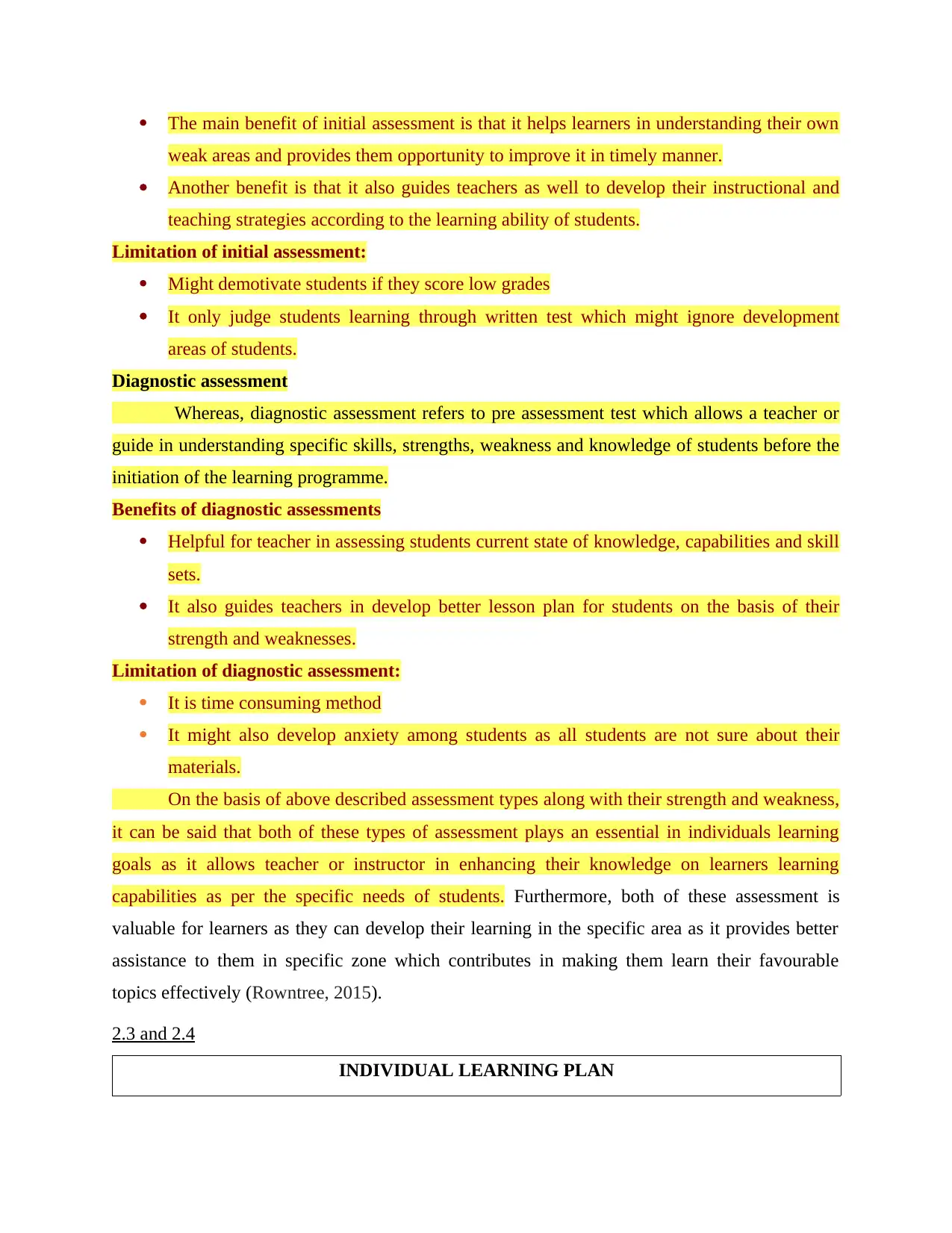
The main benefit of initial assessment is that it helps learners in understanding their own
weak areas and provides them opportunity to improve it in timely manner.
Another benefit is that it also guides teachers as well to develop their instructional and
teaching strategies according to the learning ability of students.
Limitation of initial assessment:
Might demotivate students if they score low grades
It only judge students learning through written test which might ignore development
areas of students.
Diagnostic assessment
Whereas, diagnostic assessment refers to pre assessment test which allows a teacher or
guide in understanding specific skills, strengths, weakness and knowledge of students before the
initiation of the learning programme.
Benefits of diagnostic assessments
Helpful for teacher in assessing students current state of knowledge, capabilities and skill
sets.
It also guides teachers in develop better lesson plan for students on the basis of their
strength and weaknesses.
Limitation of diagnostic assessment:
It is time consuming method
It might also develop anxiety among students as all students are not sure about their
materials.
On the basis of above described assessment types along with their strength and weakness,
it can be said that both of these types of assessment plays an essential in individuals learning
goals as it allows teacher or instructor in enhancing their knowledge on learners learning
capabilities as per the specific needs of students. Furthermore, both of these assessment is
valuable for learners as they can develop their learning in the specific area as it provides better
assistance to them in specific zone which contributes in making them learn their favourable
topics effectively (Rowntree, 2015).
2.3 and 2.4
INDIVIDUAL LEARNING PLAN
weak areas and provides them opportunity to improve it in timely manner.
Another benefit is that it also guides teachers as well to develop their instructional and
teaching strategies according to the learning ability of students.
Limitation of initial assessment:
Might demotivate students if they score low grades
It only judge students learning through written test which might ignore development
areas of students.
Diagnostic assessment
Whereas, diagnostic assessment refers to pre assessment test which allows a teacher or
guide in understanding specific skills, strengths, weakness and knowledge of students before the
initiation of the learning programme.
Benefits of diagnostic assessments
Helpful for teacher in assessing students current state of knowledge, capabilities and skill
sets.
It also guides teachers in develop better lesson plan for students on the basis of their
strength and weaknesses.
Limitation of diagnostic assessment:
It is time consuming method
It might also develop anxiety among students as all students are not sure about their
materials.
On the basis of above described assessment types along with their strength and weakness,
it can be said that both of these types of assessment plays an essential in individuals learning
goals as it allows teacher or instructor in enhancing their knowledge on learners learning
capabilities as per the specific needs of students. Furthermore, both of these assessment is
valuable for learners as they can develop their learning in the specific area as it provides better
assistance to them in specific zone which contributes in making them learn their favourable
topics effectively (Rowntree, 2015).
2.3 and 2.4
INDIVIDUAL LEARNING PLAN
⊘ This is a preview!⊘
Do you want full access?
Subscribe today to unlock all pages.

Trusted by 1+ million students worldwide
1 out of 42
Related Documents
Your All-in-One AI-Powered Toolkit for Academic Success.
+13062052269
info@desklib.com
Available 24*7 on WhatsApp / Email
![[object Object]](/_next/static/media/star-bottom.7253800d.svg)
Unlock your academic potential
Copyright © 2020–2025 A2Z Services. All Rights Reserved. Developed and managed by ZUCOL.



